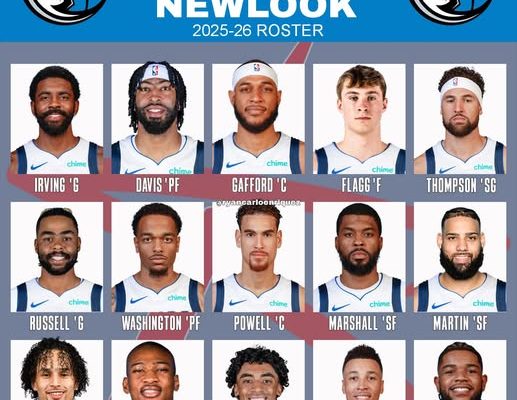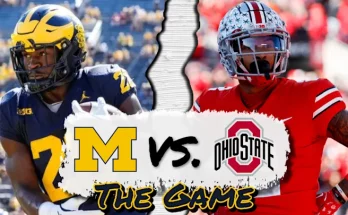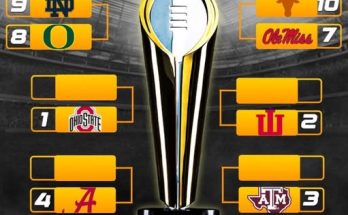Here’s an expanded 1500‑word piece on the Dallas Mavericks’ new look for the 2025‑26 season, focusing on roster construction, core philosophy, and what makes this version of the Mavs uniquely compelling—without sub‑headings.
The Dallas Mavericks enter the 2025‑26 campaign with an entirely new identity. Gone is Luka Dončić, sent in a stunning mid‑season blockbuster to the Los Angeles Lakers; in his place stands Anthony Davis, Cooper Flagg, and the promise of a more balanced, two‑way roster built around defensive strength, frontcourt dominance, and long‑term upside. The offseason has been defined by bold decisions, painful criticism, and the germination of hope for a franchise that believes its best days are ahead.
In February 2025, the Mavericks completed a seismic trade, sending franchise icon Luka Dončić along with Maxi Kleber and Markieff Morris to LA in exchange for Anthony Davis, Max Christie, and a future first‑round pick. The move shocked the NBA world, drawing backlash and derision Dallas Hoops Journal+1The Times of India+1New York Post+2Wikipedia+2Wikipedia+2. But Mavericks general manager Nico Harrison stood firm, pointing to new roster balance and defensive potential, earning praise from analysts including Shaquille O’Neal, who claimed the Mavs “won” the deal over the next two seasons The Times of India+2Wikipedia+2New York Post+2.
Fast‑forward to summer 2025, and Dallas held the No. 1 overall pick in the NBA Draft. They used it to select Duke phenom Cooper Flagg, widely acknowledged as a generational talent—the type of rare prospect GM Harrison called a “once‑in‑a‑lifetime chance” Dallas Hoops Journal+1Fadeaway World+1. The team also re-signed Kyrie Irving to a three‑year deal, despite him recovering from an ACL tear likely keeping him off the court until midseason basketnews.com. Added to the backcourt was veteran D’Angelo Russell, signed via the mid-level exception to help bridge the gap while Irving recovers Dallas Hoops Journal.
The projected Mavericks starting five appears to be: point guard Kyrie Irving (when healthy), shooting guard Klay Thompson, small forward Cooper Flagg, power forward Anthony Davis, and center Dereck Lively II Wikipedia+15Diario AS+15ClutchPoints+15. Beneath the surface lies a deep mix of veterans and dark‑horse youth: Spencer Dinwiddie brings playoff seasoning; Naji Marshall and PJ Washington provide wing versatility. Max Christie, acquired in the same trade that sent Dončić out, is a defensive-minded wing with upside, while Daniel Gafford and Dwight Powell bolster backup frontcourt depth Wikipedia+9SI+9Fadeaway World+9.
This roster reveals Dallas’s philosophy: a shift from the Luka‑centric attack to hybrid ball movement, defensive accountability, and interchangeable size. Anthony Davis anchors that vision. In just nine regular‑season games last year in Dallas, he averaged 20.0 points, 10.1 rebounds, 4.4 assists, and showed game‑changing rim protection; he even dropped 40 points in a Play‑In game against Memphis Dallas Hoops Journal. Teams around him now face a versatile frontcourt duo in Davis and the evolving Dereck Lively II, whose early NBA career (8.7 points, 7.5 rebounds, 1.6 blocks per game) was cut short by injury. He’s recovered and expected to play a larger role in extended two‑big lineups that emphasize spacing and pick-and-pop actions Dallas Hoops Journal.
Cooper Flagg represents the franchise’s future—an elite defender with ball‑handling and court vision. In Las Vegas Summer League, he dazzled with a 31‑point performance before being shut down as a precaution, but coaching staff immediately began giving him real responsibilities: initiating transition, operating from high post, functioning as a point‐forward to accelerate his growth Dallas Hoops JournalSIFadeaway WorldWikipedia. While Irving is sidelined, D’Angelo Russell will assume starting point guard duties, initiating pick-and-rolls and collaborating with Flagg and Davis to craft a more democratic offense The Times of India+8Dallas Hoops Journal+8SI+8.
Klay Thompson remains the veteran shooting presence and playoff-tested champion. His ability to space the floor and defend has been invaluable, and paired with Max Christie, PJ Washington, and Naji Marshall, gives Dallas a varied and versatile wing rotation SIRealGM BasketballWikipedia. Coach Jason Kidd is expected to lean on wing size and positional flexibility when designing his rotation.
The guard rotation is loaded with question marks and internal competition. Dinwiddie, recovering from a previous departure and return, adds grit and scoring off the bench. Brandon Williams, a two‑way guard who flashed scoring upside, and Ryan Nembhard, a 2025 undrafted signing with elite assist numbers in college, compete for minutes behind Russell and Irving mavsmoneyball.com+15The Smoking Cuban+15Dallas Hoops Journal+15Dallas Hoops Journal. Veteran Dante Exum may return if the Mavs agree on a minimum deal, bringing secondary ball movement and defense to the roster The Times of India+2Dallas Hoops Journal+2The Times of India+2.
Max Christie, the former Laker included in the trade for Dončić, looks to elevate his game under coach Phil Handy. Analysts see him as a potential breakout wing whose defensive chops and lateral mobility fit Kidd’s vision for long, switchable lineups YouTubeSIFadeaway World. PJ Washington continues at power forward slot, providing floor spacing and rebounding for both Davis and Flagg alignment Dallas Hoops Journal. Daniel Gafford and Dwight Powell hold down backup five spots with complementary athleticism and pick‑and‑roll proficiency.
Beyond the main rotation, Dallas added several undrafted rookies to fill two-way slots and exhibit contract deals. Among them, Ryan Nembhard stood out as a creative playmaker from Gonzaga (led NCAA in assists), while Miles Kelly and other signees offer depth at the wing and guard positions Fadeaway WorldThe Smoking Cuban.
With this new roster in place, pundits are split. ESPN’s early power rankings placed Dallas at No. 14 in the West, citing the major upheaval and uncertain timeline SI. Others look to the future: Bleacher Report and Clutch Points argue Flagg changes everything, and some prognosticators expect a title win within three years if he, Davis, and Irving can mesh effectively ClutchPoints+1SI+1.
Much of Dallas’s ceiling depends on Kyrie Irving’s ACL recovery. Last season before he tore it, Irving was averaging 24.7 points, 4.8 rebounds, 4.6 assists on near‑50 % shooting. He signed a $119M contract extension, reinforcing the team’s belief in his long‑term role Dallas Hoops Journal. If he returns midseason at full strength and integrates alongside Davis and Flagg, the offense has the potential to be elite; if not, the first half of the year may see growing pains in late‑game execution and playmaking.
GM Nico Harrison, once the center of fan ire over the Dončić trade, has received renewed praise for constructing arguably one of the NBA’s best front lines, combining Davis, Flagg, Lively, and Christie in one big core Wikipedia+5Dallas Hoops Journal+5The Times of India+5. Critics remain vocal, though. Some outlets argue the loss of draft capital and failed buy‑in from fans demand leadership changes; others dismiss Dallas’s future unless the new core immediately delivers on playoff success mavsmoneyball.comlmtonline.com.
The Mavericks are betting on balance, versatility, and two‑way cohesion. Their projected strengths include elite frontcourt size, defensive length, shooting from Thompson and Washington, and playmaking from both Davis and Flagg. Weaknesses center around health — especially Irving and Davis — guard depth and offensive rhythm without Luka’s singular presence.
Look for Dallas to begin the season with D’Angelo Russell holding the point, Flagg likely in the starting lineup by midyear, and Irving returning in January or February. Davis and Lively will alternate starts at the five, while PJ Washington and Christie fight for regular wing minutes. The bench mix—Dinwiddie, Marshall, Hardy, Exum, Nembhard, and others—gives Kidd flexibility, but also demands development from young players to avoid a stagnant rotation.
This Mavericks collection doesn’t rely on a single star to create; instead, they aim to function as a unit. The arrival of Davis and Flagg signals a radical reshaping of identity: athletic frontcourt, switchable defense, ball movement initiated by forwards, and a broader distribution of responsibilities. Legacy players like Thompson, Dinwiddie, and Washington offer stability and championship culture to anchor the new era.
As the season unfolds, questions abound. Can Kyrie return in time and form? Will Flagg fulfill generational expectations as a true two‑way star? Can young wings like Christie and Nembhard hold their own in a brutal Western Conference? Will internal depth be sufficient if injuries hit? Can Harrison’s front office vision survive scrutiny if the team falls short of playoffs?
The 2025‑26 Dallas Mavericks are not the same franchise that trained Luka Dončić to superstardom. This is a team that has willingly torn up its past to embrace a new direction, hoping frontcourt power and collective pedigree can translate into wins. Whether the risk pays off or results in more disappointment remains to be seen, but one thing is clear: Dallas is now a new kind of Mavs — built for the next chapter, whatever that brings.



